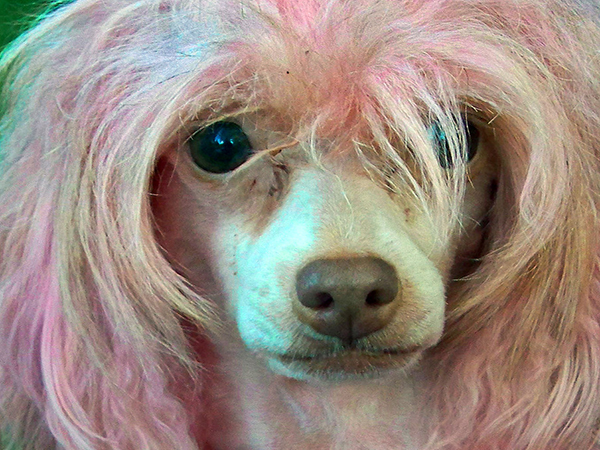How Safe is Pet Hair Dye?
|
Feb 21, 2024 - By the dedicated team of editors and writers at Newsletter Station.

|
Pet owners are known for their creativity in pampering and expressing their love for furry friends. They often showcase their affection by experimenting with pet hair dye to give their pets a unique and colorful look. While this trend may seem fun and harmless, it's essential to consider the safety of using hair dye on pets.
In this blog, we will explore the topic of pet hair dye safety, its potential risks, and alternatives to ensure your pet's well-being.
Understanding Pet Hair Dye
Pet hair dye is specially formulated for animals and typically differs from human hair dye in terms of ingredients and application. These products are designed to be safe for pets and come in various colors and forms, such as spray-on, semi-permanent, or temporary chalks. Despite their intended safety, several factors must be considered before using pet hair dye.
Potential Risks
- Allergic Reactions:
Like humans, pets can have allergies to certain chemicals and substances. Pet hair dyes often contain ingredients that may trigger allergic reactions in some animals, leading to itching, redness, or skin irritation.
- Ingestion:
Pets are notorious for grooming themselves, and this can pose a significant risk if they ingest hair dye chemicals. Swallowing even small amounts of dye can be harmful, causing gastrointestinal distress, poisoning, or more severe health issues.
- Skin Sensitivity:
Some pets may have more sensitive skin than others, making them more prone to irritation from hair dye products. Testing a small area of your pet's skin before applying any dye to their entire coat is crucial.
- Pre-existing Conditions:
Pets with pre-existing skin conditions or allergies should avoid pet hair dye altogether, as it could exacerbate their health problems.
- Stress:
The application process can be stressful for many pets. The noise of the hairdryer, the sensation of being sprayed, or the physical handling can cause anxiety and discomfort in some animals.
Safety Measures
If you still wish to try pet hair dye, here are some safety measures to follow:
- Consult Your Vet:
Seek advice from your veterinarian before using any pet hair dye products. They can evaluate your pet's health and skin condition to determine if it's safe to proceed.
- Choose High-Quality Products:
Opt for reputable brands that specifically manufacture pet-friendly hair dye products. Read the labels and look for non-toxic and hypoallergenic options.
- Perform a Patch Test:
Test a small, inconspicuous area of your pet's coat to check for any allergic reactions or adverse effects before applying the dye.
- Apply with Care:
Follow the manufacturer's instructions carefully. Be gentle and patient during the application process to minimize stress for your pet.
- Monitor Your Pet:
Keep a close eye on your pet after applying the hair dye to ensure they don't experience any adverse reactions. If you notice any unusual behavior or symptoms, contact your vet immediately.
Alternatives to Pet Hair Dye
If you're concerned about the safety of pet hair dye or your pet's temperament, consider these alternatives to express your creativity and love for your pet:
- Pet-Friendly Accessories:
Opt for colorful pet accessories like bandanas, bows, or collars. These items are easy to put on and remove without causing any harm to your pet.
- Temporary Hair Chalk:
Non-toxic, temporary hair chalk can be applied to your pet's fur for a vibrant look that washes out easily.
- Dye-Free Grooming Products:
Invest in high-quality grooming products that enhance your pet's natural coat color and shine without using dyes.
While pet hair dye can be a fun and creative way to express your love for your furry companion, it's crucial to prioritize their safety and well-being. Always consult your veterinarian, choose safe products, perform patch tests, and closely monitor your pet for adverse reactions.
If you have any doubts or concerns, consider alternative ways to pamper and beautify your pet that don't involve the potential risks associated with hair dye. Ultimately, your pet's health and happiness should be your top priority.
Unlock the Power of Email Marketing
Harness the potential of email marketing with Newsletter Station. Reach your target audience, drive conversions, and achieve your business goals.
|
More Blogs
| May 8, 2024 |
How to Protect Your Dog's Paws: Tips for a Happy and Healthy Furry Friend
|
| May 1, 2024 |
Tips for Removing a Tick from Your Pet
|
| Apr 24, 2024 |
How to Know When It Is Too Hot to Walk Your Dog
|
| Apr 17, 2024 |
What to Do When Your Pet Isn't Eating
|
| Apr 10, 2024 |
What Causes Bad Breath in Dogs and Cats?
|
| Apr 3, 2024 |
What Causes Cysts in Dogs: Understanding Canine Cyst Formation
|
| Mar 26, 2024 |
Toxic Plants for Cats: Protecting Your Feline Friends
|
| Mar 20, 2024 |
Reasons Your Dog Is Licking Its Paws
|
| Mar 13, 2024 |
Ways to Deal with Dog Separation Anxiety
|
| Mar 6, 2024 |
Identifying Food Allergies in Dogs and Cats
|
| Feb 28, 2024 |
Spotting the Early Signs of Dementia in Your Aging Dog
|
| Feb 21, 2024 |
How Safe is Pet Hair Dye?
|
|
|
|